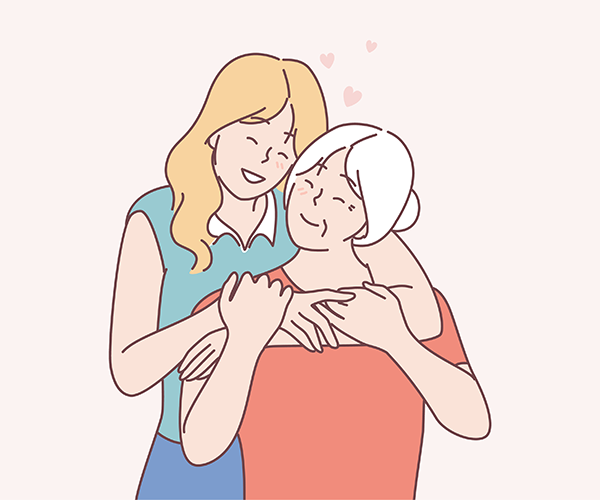
Jessica Tong fondly recalls the love she felt for her grandmother while playing mah-jong.
Feb. 13, 2023

You don’t have to be a fan of Modern Love (a romance franchise that began as a column in The New York Times and has grown to include a podcast and a Netflix series) to enjoy a couple of random love stories connected to UCalgary.
In no particular order, you’ll find short stories that are tender, quirky, sweet and sad — love is, indeed, a many-splendoured thing — for Valentine’s Day.
Every summer was the same.
Even when I was very young, I would leave my mom in Calgary and fly to Vancouver to spend time with my extended family from Hong Kong.
What I remember most were the days I spent at my grandmother’s walkout suite. I was very shy, so I would sit obediently and survey her living quarters: one long black couch, an old, deep “big box” TV, her colourful phone (the horizontal kind, not an upright), a white fridge next to a sink and small counter.
On the counter were small snacks: drinks in boxes (soy milk, sesame milk, some chrysanthemum tea, lemon tea), fruit, instant noodles, etc. Everything, except for the couch, phone and TV, was white. For some reason, the screen door was always open, so it was always breezy and pleasantly coolish.
And then I’d hear it.
The sound, a sort of clack, of mah-jong tiles being shuffled by my grandma. And there was always a clock tick-tocking somewhere in her place that also served to ratchet up my anxiety — just like Jeopardy music — as I tried to keep pace with her.
We would speak Cantonese together (she never did learn to speak English) and she would whomp me, game after game, snack after snack. She’d laugh and prod me to play faster, but I never got speedy or ever reached her level. Not even close.
Honestly, playing mah-jong (a cross between rummy and bridge) with my gram made math in school look simple. Math, probability, luck and a memory are things you need to play; my grandma had them in spades.

Jessica Tong fondly recalls the love she felt for her grandmother while playing mah-jong.
She’s 102 now and I haven’t seen her since before COVID. My aunties and uncles tell me she doesn’t play mah-jong anymore.
So, as a legacy, I’ve decided to teach my friends how to play. And now I think of my gram when I shuffle the “deck,” but it’s not the same. Sometimes, I wonder if I should buy a small carton of sesame milk or chrysanthemum tea? Or a loud clock?
In truth, I miss her. The wonder I felt as I watched her elegant fingers flip each tile over, reading the dots and bams and Chinese characters as though it was Braille, comes back with each click and clack.
Sometimes, I wonder if the ancient game might be a bit of a character-meter. Perhaps that’s why I came to think of my grandma as someone who is funny, sharp, generous and honest.
Perhaps there was magic in those tiles? — Jessica Tong, BA’21, junior communications specialist, UCalgary
Of course, I knew the time would come . . . when your unwavering belief in tooth fairies and witches and Santa Claus and the man in the moon would end. But I didn’t see this particular day coming.
And it cracked my heart. Wide open. Not to be a pop psychologist, but I had read Barbara Coloroso, and so I knew the “rules” and that they were healthy and normal and likely good for us, but so is Durian fruit and I can’t stand the stuff.
The moment began like any other after-school time. Oversized knapsacks were dropped at the door, shoes were kicked off and you and your brother, Quinn, would bolt up to your rooms to do who-knows-what. That’s when I would begin dinner prep with CBC as my stalwart companion.
In a typical 4-6 p.m. slot, you and your brother would drift down to the kitchen after playing for about an hour to have a snack and share your highlight reel of the day. If you were late, and I had time, I would sometimes stand outside your closed bedroom doors and listen.
Quinn was always in another galaxy, making webs of wool around furniture and his vast empire of Lord of the Rings characters.

Deb Cummings remembers the day the voices stopped
You, on the other hand, re-enacted your day — sort of. Sometimes, you were the librarian, the teacher, the principal, a big kid at recess. Conversations got replayed, edited, rewritten and then played again.
No matter the role, you were always the main character. (And today, so many years later, you remain the same. Strong, but adaptable; good with accents and character plays; compassionate, reasonable, smart, insightful . . . were you fully formed at eight?)
But I digress. There I was at the kitchen counter, chopping an onion (this is a key item for soon after, tears were streaming down my cheeks) when you came down in your pink Pocahontas (sorry) sweatshirt, barrettes all akimbo and socks that didn’t match (they never did). You were early . . . your hour wasn’t up, which I noticed on the oven clock.
“What’s up, Buttercup?” I asked, innocently, expecting you to divulge a critical scene of some schoolyard drama.
But you said nothing and looked so woebegone. I scooped you up, moved aside the breadboard and placed you on the counter, eye to eye. I still remember your rosy cheeks and shiny hair, but most of all I remember your big, black, wet eyes.
And then you spoke. Your voice cracking, a little.
“Mum, they don’t talk to me anymore,” you said, a tear trickling down your face. “They’ve stopped.”
“Who?” I asked, all guns a-blazing, ready to take on some — any — disloyal friend or schoolyard bully.
“My dollies.”
I was not ready for this . . . this tragedy, where the “Wonder Years” come to a blinding stop. This called for an intervention — of epic proportions. It was Chunky Monkey time. We tucked into the pint of Chunky Monkey and discussed off-days and wondered if the voices were just sick or in hiding and whether they’d come back. Eventually.
They never did. — Deb Cummings, MEd'17, lead, alumni storytelling and engagement, UCalgary
There’s a photo of the two of them, dated 1999, Delhi. Both appear to be keeping their distance, just two typical students (we discover later) on a clinical psychology practicum with no chart, no linear map, to their future. Stare a little closer and Shaminder Singh looks, well . . . like’s he’s staring, sort of swooning as though he’s already smitten with Sumeeta Kapoor.
“I likely was,” admits Singh , PhD’19, now an assistant professor of nursing and midwifery at Mount Royal University.
“For me, it was love at first sight. But, remember, I was a village guy and she was a city girl and our families did not agree that we should marry,” he adds, quickly. “Ever. They made that abundantly clear.”

When families don't agree on a marriage, a tug-of-war ensues
“In India,” explains Singh, “marriage is not perceived as a relationship between two people but as a relationship between families in a community.”
And so began a five-year complex tug-of-war between not only opposing parents but also relatives, workplaces, in fact, their entire communities. While that backdrop was unfurling, Singh and Kapoor were trying to focus on higher education and future careers in psychology while constantly striving to convince their families.
Finally, in 2004, both families accepted and allowed the couple to marry. But the bumps and junctures didn’t end. Two years later, the couple moved to teach high school in South Carolina and three years after that to Calgary to pursue nursing degrees.
Now, years later, both with solid careers, Singh says “our parents and siblings finally fully approve of us and our marriage, and they seem proud of us. But we know from experience, it requires a lot of active work to smooth the edges of a relationship when you are from two different cultures. It’s never easy, and probably, that is why our families resisted initially.”
“Overall,” adds Singh, “we think that love and relationships are not passive ventures; we work like a team to actively manage them by accepting and arguing, supporting each other, having open and honest communication, and celebrating small successes in life.
“When nothing else works, our cultural values support us, including the value that marriage is about two people and reaches beyond time. If we experience a storm, we hang tight and let it pass, knowing it will.” — As told to Deb Cummings. This interview has been edited and condensed.
To read more love stories, read Part 2.